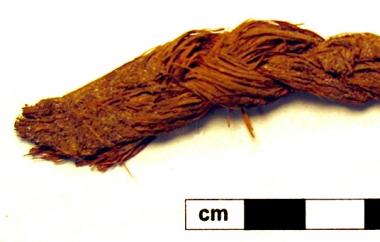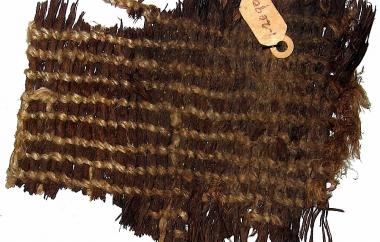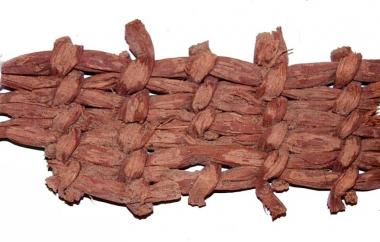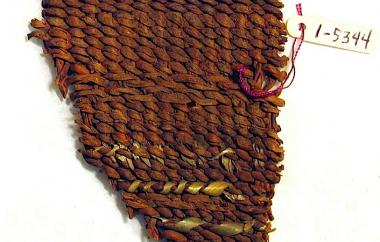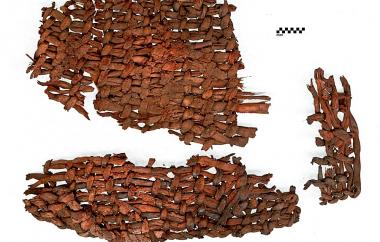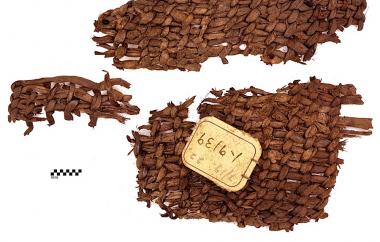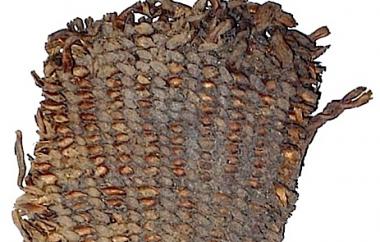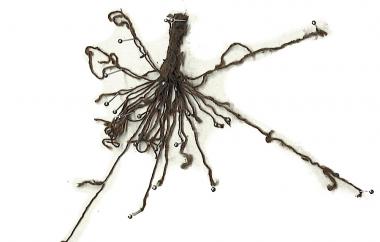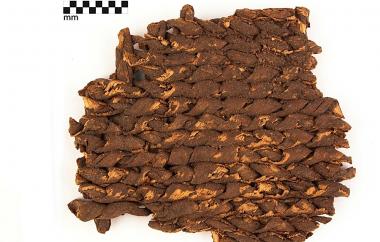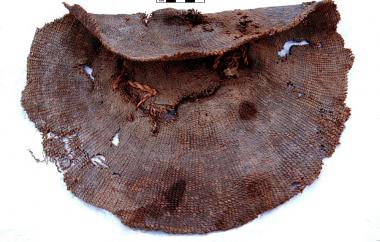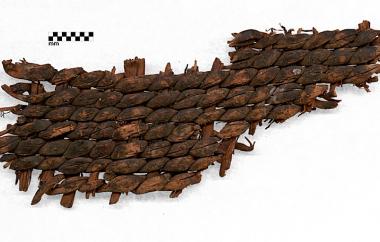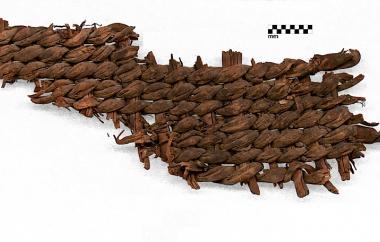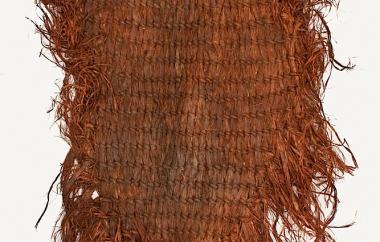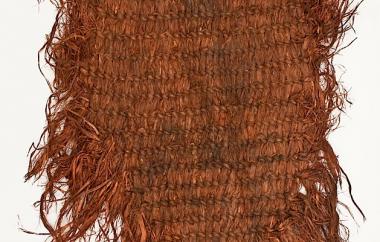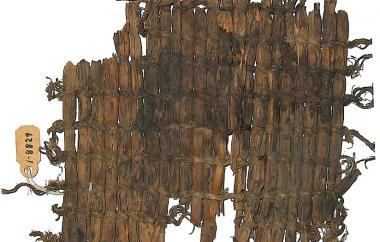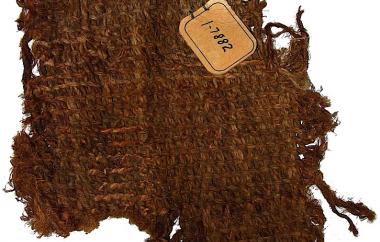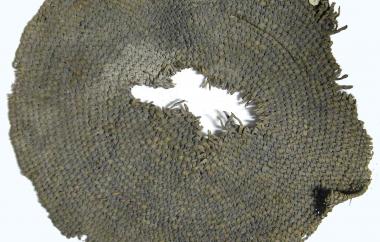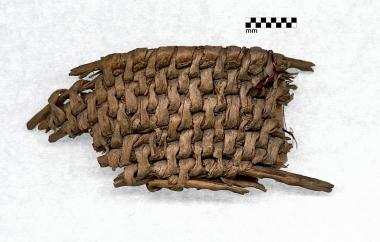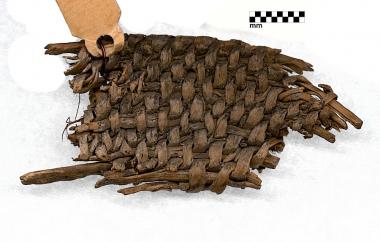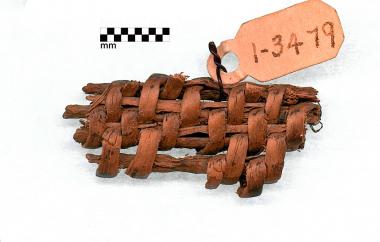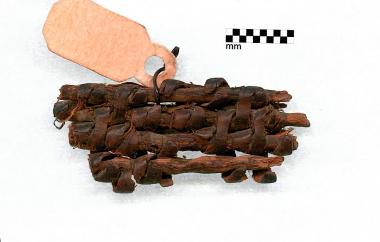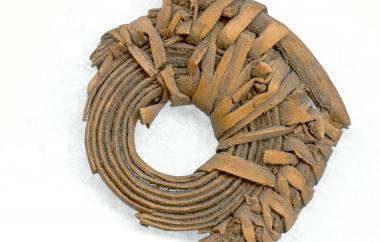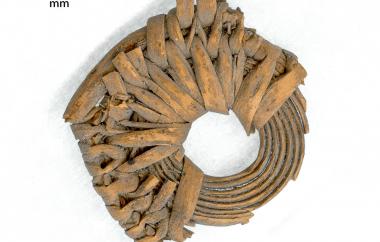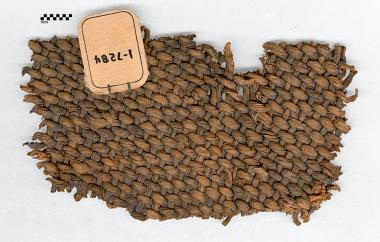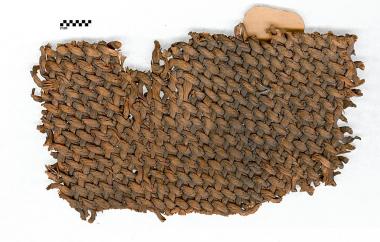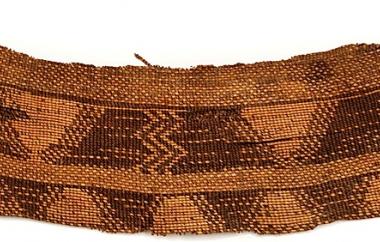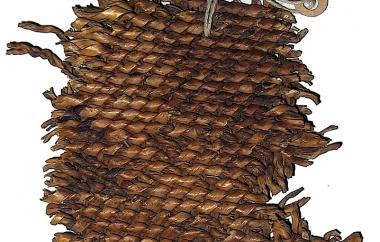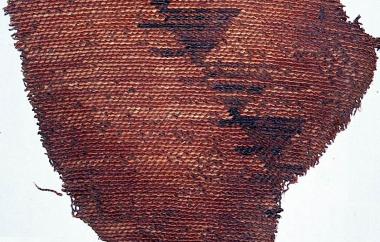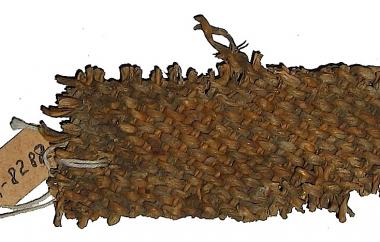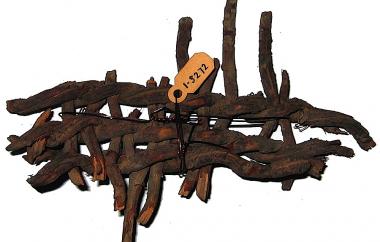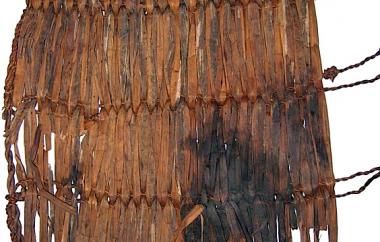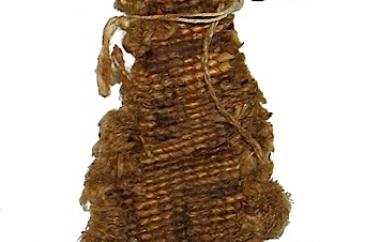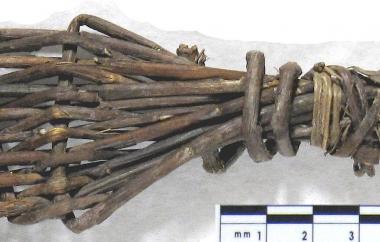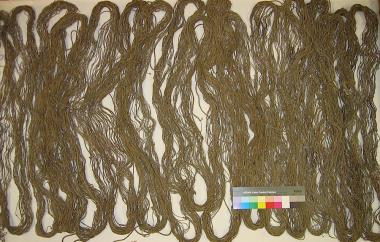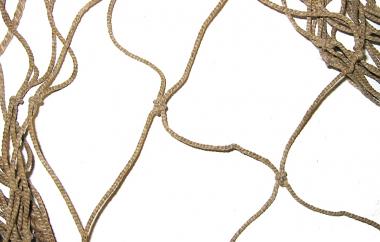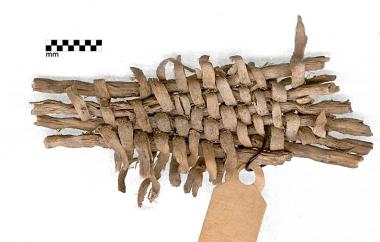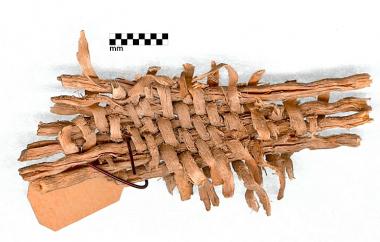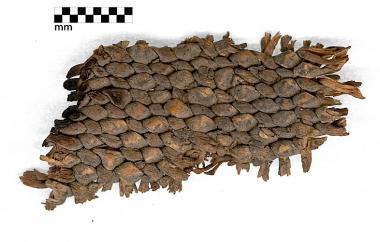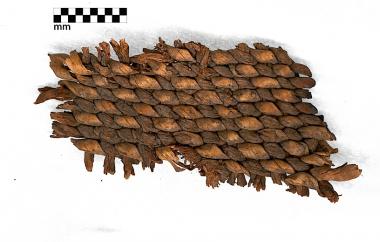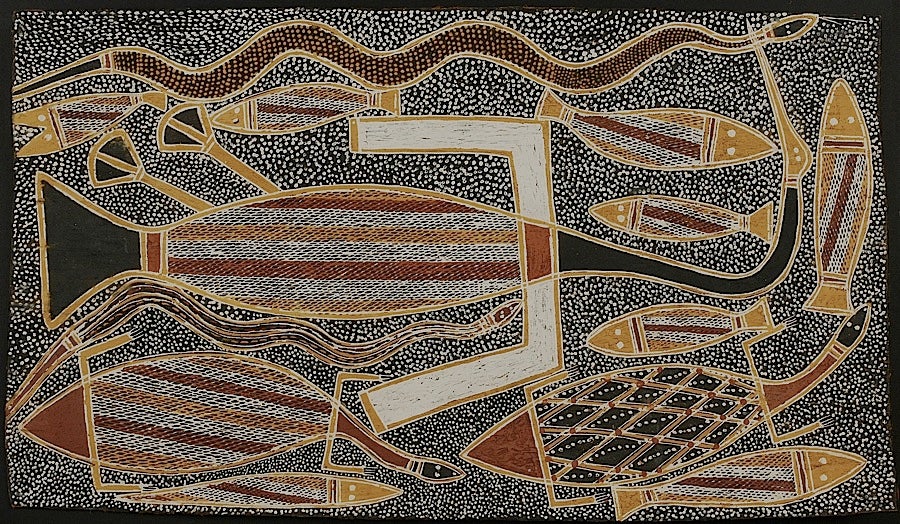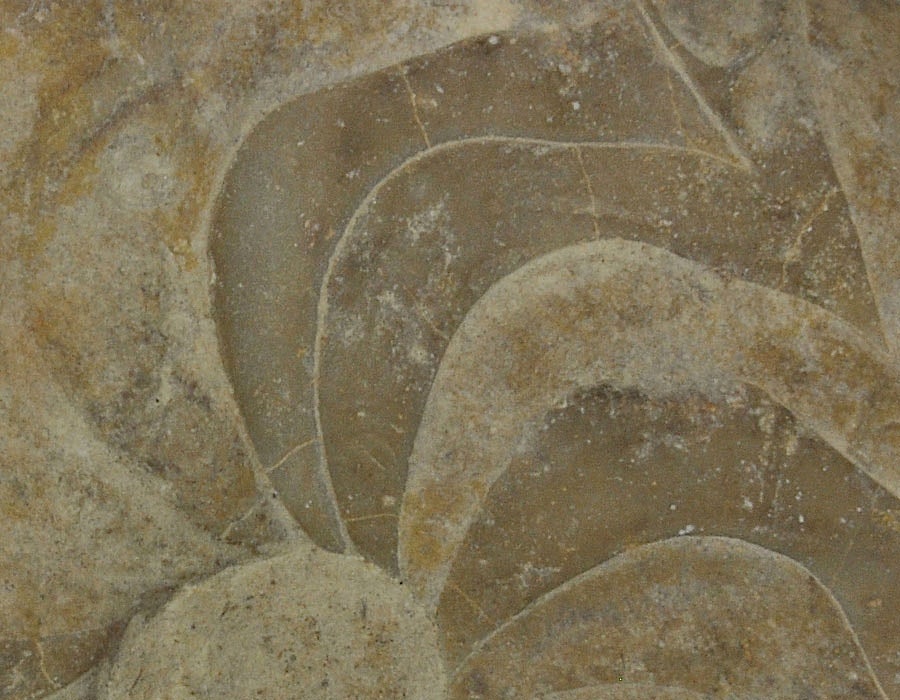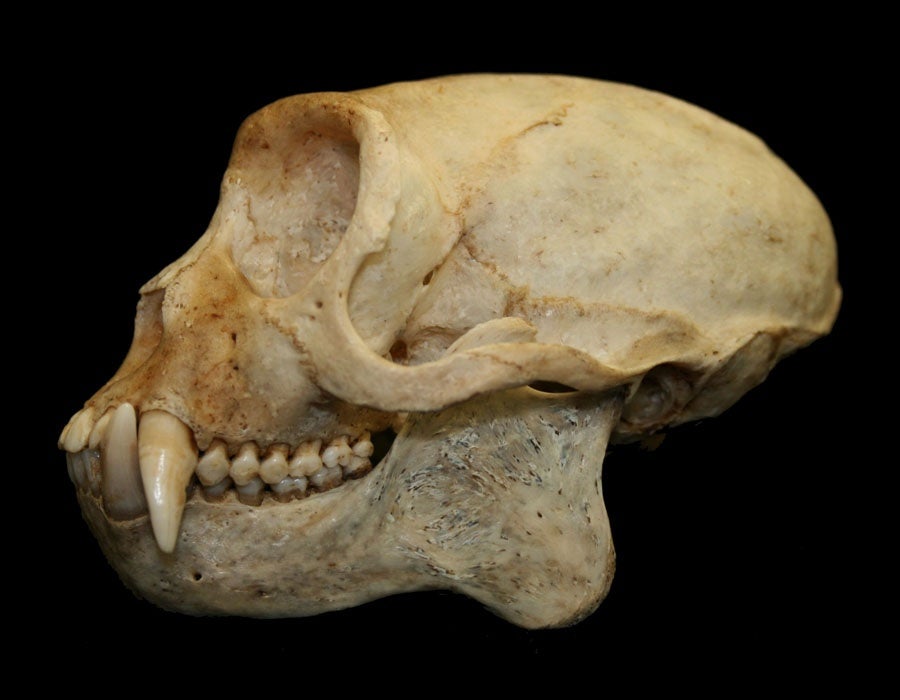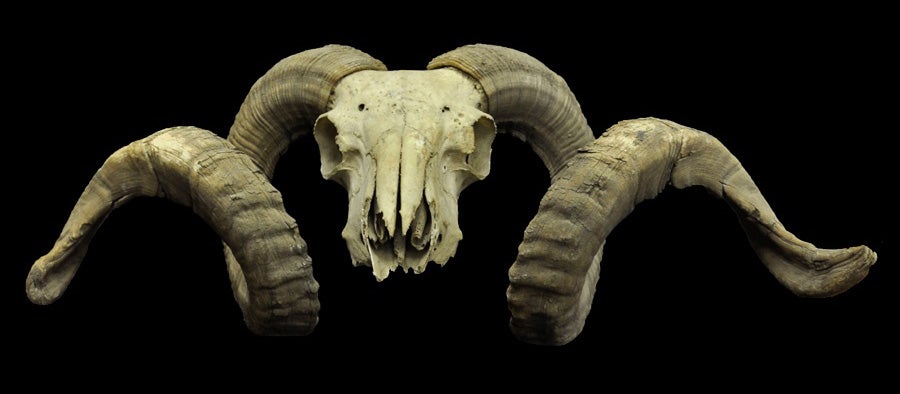The museum holds significant collections of ancient basketry uncovered by archaeologists in dry caves of the Desert West. Using AMS radiocarbon dating, tiny samples of these unique objects can now be accurately dated, illuminating a deep and complex history of weaving traditions in western North America. The museum conducts an ongoing fiber artifact dating program in partnership with the Nevada State Museum, the University of Nevada, Reno, and the Bureau of Land Management.
In addition to the gallery offered here, we invite you to explore our searchable Northern Great Basin Archaeological Perishables Catalog, part of the museum's Anthropological Collections online database.
At present, the earliest woven artifact from Oregon is a strand of braided sagebrush bark from Paisley Caves, directly dated to ~12,000 years ago. Fort Rock-style sandals range in age from over 10,000 to about 9,300 years old, and woven baskets span the past 8,000 years.
Oregon's ancient basketry was made with three basic techniques: twining, plaiting, and coiling. Twining, in which a pair of weft elements is twisted (or twined) around opposing warp elements, is the most common in Oregon and along the north Pacific Coast. Plaiting, the simple over-and-under interweaving of opposing fibers, is a common basket-making technique, but rare in Oregon. Coiled baskets, built up from a spiraling foundation element, are relatively rare in Oregon. Coiled baskets are sometimes described as 'sewn' because the outer coil is attached to the previous one by stitching.
Our extensive northern Great Basin basketry collections are dominated by a twining technique centered in southeast Oregon and nearby areas in Nevada and California. Twined basketry is abundant in southeast Oregon after about 8,000 years ago, including Catlow twineware similar in materials and structure to historic basketry of the Klamath and Modoc Indians. Catlow Twine is a flexible basketry made primarily from marsh reeds using a two-ply cord warp and a counter-clockwise weft twist.
Many decorative variations are present in the region’s twineware, including overlay, false embroidery, and diagonal twining. Overlay uses a fiber of contrasting color over the structural fibers with which it is twisted, so the decorative fiber is oriented with the structural. False embroidery uses a contrasting fiber to wrap the structural fiber, so the decorative element is at right angles to the structural. In diagonal twining, wefts engage two warps at a time, alternating weft pairs with each row.
Coiled baskets, comprising only about 2 percent of our archaeological basketry, are found in eastern Oregon sites in Harney and Malheur Counties, where directly-dated examples all fall within the last 2,500 years.
Images © UO Museum of Natural and Cultural History. Production of this gallery received generous support from The Ford Family Foundation.
Adovasio, James M.
1986 Prehistoric Basketry. In Handbook of North American Indians: Volume 11, Great Basin, edited by Warren L. D'Azevedo, pp. 194-205. Smithsonian Institution, Washington, D.C.
Connolly, Thomas J.
1994 Prehistoric Basketry from the Fort Rock Basin and Vicinity. In Archaeological Researches in the Northern Great Basin: Fort Rock Archaeology Since Cressman, edited by C. Melvin Aikens and Dennis L. Jenkins, pp. 63-83. University of Oregon Anthropological Papers 50. Eugene.
2004a The Implications of Recent Basketry Dating Efforts for Northern Great Basin Cultural History. Paper presented at the Northwest Anthropological Conference, Eugene, Oregon.
2004b The Perishable Assemblages from the Connley and Paisley Caves, Oregon. Paper presented at the Great Basin Anthropological Conference, Sparks, Nevada.
2006 Implications of New Radiocarbon Ages on Coiled Basketry from the Northern Great Basin. Paper presented at the Great Basin Anthropological Conference, Las Vegas, Nevada (publication pending in a thematic basketry volume in the Journal of California and Great Basin Anthropology).
Connolly, Thomas J. and Pat Barker
2004 Basketry Chronology of the Early Holocene in the Northern Great Basin. In Early and Middle Holocene Archaeology of the Northern Great Basin, edited by D. L. Jenkins, T. J. Connolly, and C. M. Aikens, pp. 241-250, University of Oregon Anthropological Papers 62, Eugene.
Connolly, Thomas J., Catherine S. Fowler, and William J. Cannon
1998 Radiocarbon Evidence Relating to Northern Great Basin Basketry Chronology. Journal of California and Great Basin Anthropology 20(1):88-100.
Cressman, Luther S.
1986 Prehistory of the Northern Area. In Handbook of North American Indians, Volume 11: Great Basin, edited by Warren L. D'Azevedo, pp. 120-126. Smithsonian Institution, Washington, D.C.
Fowler, Catherine S., Eugene M. Hattori, and Amy J. Dansie
2000 Ancient Matting from Spirit Cave, Nevada: Technical Implictions. In Beyond Cloth and Cordage: Archaeological Textile Research in the Americas, edited by Penelope Ballard Drooker and Laurie D. Webster, pp. 119-139. University of Utah Press, Salt Lake City.
Cat. #2-3C-31
Three-strand braid, sagebrush bark
10290 ± 40 BP (Beta-195908), ~12,000 cal BP
Jenkins excavation, 2003
Paisley Caves
Cat. #1-2690
Open simple twine basketry fragment
Sagebrush bark warp and hemp weft
8625 ± 56 BP (AA-74221), ~9610 cal BP
10 x 8 cm - Cressman excavation, 1937
Catlow Cave
Cat. #A3-6/1-B68
Open diagonal twine basketry fragment, tule
6950 ± 110 BP (AA-19154), ~7770 cal BP
11 x 4 cm - Excavation, 1973
Dirty Shame Rockshelter
Cat. #1-5344
"Catlow Twine" basket fragment
Decorated with false embroidery
6560 ± 70 BP (AA-19153), ~7450 cal BP
9.5 x 7 cm - W. Perry donation, 1937 - Connolly et al. 1998
Paisley Caves
Cat. #1-9139
Open diagonal twine basket fragments (side one)
6277 ± 55 BP (AA-30060), ~7230 cal BP
Cressman excavation, 1938 - Connolly 2004a
Fort Rock Cave
Cat. #1-9139
Open diagonal twine basket fragments (side two)
6277 ± 55 BP (AA-30060), ~7230 cal BP
Cressman excavation, 1938 - Connolly 2004a
Fort Rock Cave
Cat. #15-D-9-2
"Catlow Twine" basket fragment, decorated with fiber overlay
4590 ± 50 BP (Beta-164958), ~5310 cal BP
Jenkins field school, 2001 - Connolly 2004b
Connley Caves
Cat. #15-C-11-5
Fine net fragment
4520 ± 40 BP (Beta-164959), ~5220 cal BP
Jenkins field school, 2001 - Connolly 2004b
Connley Caves
Cat. #1-14707
"Catlow Twine" basket fragment (side one), false embroidery decoration
4430 ± 60 BP (AA-19150), ~5000 cal BP
D. B. McFadyen donation, 1950 - Connolly et al. 1998
Fort Rock Cave
Cat. #1-14707
"Catlow Twine" basket fragment (side two), false embroidery decoration
4430 ± 60 BP (AA-19150), ~5000 cal BP
D. B. McFadyen donation, 1950 - Connolly et al. 1998
Fort Rock Cave
Cat. #15-C-12-15
Close-twined tray
4240 ± 50 BP (Beta-164960), ~4830 cal BP
Jenkins field school, 2001 - Connolly 2004b
Connley Caves
Cat. #1-8303
Close simple twine basketry fragment (side one), rigid warp, S-twist weft
3960 ± 40 BP (Beta-249781), ~4420 BP
Cressman excavation, 1938
Roaring Springs Cave
Cat. #1-8303
Close simple twine basketry fragment (side two), rigid warp, S-twist weft
3960 ± 40 BP (Beta-249781), ~4420 BP
Cressman excavation, 1938
Roaring Springs Cave
Cat. #1-7298
Open simple twine mat or apron (side one), sagebrush bark
3020 ± 40 BP (Beta-249777), ~3230 cal BP
Cressman excavation, 19
Roaring Springs Cave
Cat. #1-7298
Open simple twine mat or apron (side two), sagebrush bark
3020 ± 40 BP (Beta-249777), ~3230 cal BP
Cressman excavation, 1938
Roaring Springs Cave
Cat. #1-8829
Open simple twine basketry fragment
2637 ± 40 BP (AA-74227), ~2770 cal BP
11.5 x 12 cm - Cressman excavation, 1938
Roaring Springs Cave
Cat. #1-7882
Open diagonal twine basketry fragment
Sagebrush bark warps and hemp wefts with false embroidery
2493 ± 46 BP (AA-30058), ~2600 cal BP
13 x 11 cm - Cressman excavation, 1938
Roaring Springs Cave
Cat. #1-8623b
Coiled basket fragment
2471 ± 51 BP (AA-66193), ~2600 cal BP
Cressman excavation, 1935 - Connolly 2006
Roaring Springs Cave
Cat. #419-2811
Close diagonal twine tray, S-twist weft
2250 ± 40 BP (Beta-249780), ~2320 cal BP
41 x 46 cm - Bedwell excavation, 1966
Table Rock Cave
Cat. #1-2120
Coiled basket fragment
1850 ± 42 BP (AA-66189), ~1820 cal BP
Cressman excavation, 1935 - Connolly 2006
Catlow Cave
Cat. #1-2120
Coiled basket fragment
1850 ± 42 BP (AA-66189), ~1820 cal BP
Cressman excavation, 1935 - Connolly 2006
Catlow Cave
Cat. #1-3479
Coiled basketry (side one)
1850 ± 40 BP (Beta-249774), ~1810 cal BP
Cressman excavation, 1937
Catlow Cave
Cat. #1-3479
Coiled basketry (side two)
1850 ± 40 BP (Beta-249774), ~1810 cal BP
Cressman excavation, 1937
Catlow Cave
Cat. #1325-34
Coiled rings (side one), wood fiber
1760 ± 40 BP (Beta-249778), ~1700 cal BP
Connolly et al. 1998
Antelope Overhang
Cat. #1325-34
Coiled rings (side two), wood fiber
1760 ± 40 BP (Beta-249778), ~1700 cal BP
Connolly et al. 1998
Antelope Overhang
Cat. #1-7284
Close cross-warp twining basketry fragment (side one)
1630 ± 40 BP (Beta-249776), ~1530 cal BP
Cressman excavation, 1938
Roaring Springs Cave
Cat. #1-7284
Close cross-warp twining basketry fragment (side two)
1630 ± 40 BP (Beta-249776), ~1530 cal BP
Cressman excavation, 1938
Roaring Springs Cave
Cat. #1-8710
"Catlow Twine" large basket rim (side one), with overlay
1110 ± 40 BP (Beta-249773), 1020 cal BP
Cressman excavation, 1938
Roaring Springs Cave
Cat. #1-8710
"Catlow Twine" large basket rim (side two), with overlay
1110 ± 40 BP (Beta-249773), 1020 cal BP
Cressman excavation, 1938
Roaring Springs Cave
Cat. #1-8756
Close cross-warp twining basketry fragment, false embroidery decoration
1041 ± 38 BP (AA-74226), ~970 cal BP
6.5 x 6.5 cm - Cressman excavation, 1938
Roaring Springs Cave
Cat. #1-4711
Closed simple and diagonal twine basket
False embroidery and 3-strand overlay
1030 ± 45 BP (AA-30057), ~940 cal BP
25 x 25 cm - Cressman excavation, 1937 - Connolly 2004a
Roaring Springs Cave
Cat. #1-8282
Close cross-warp twine basketry fragment
False embroidery decoration
1014 ± 32 BP (AA-74223), ~940 cal BP
7 x 3 cm - Cressman excavation, 1938
Roaring Springs Cave
Cat. #1-3272
Open diagonal twine basketry fragment
Rigid warp and weft, S-twist weft
720 ± 34 BP (AA-74222), ~680 cal BP
14 x 8 cm - Cressman excavation, 1937
Catlow Cave
Cat. #1-8779a
Open diagonal twine basketry, warp-face plaiting
540 ± 50 BP (UCR-3527/CAMS-34514), ~540 cal BP
Cressman excavation, 1938 - Fowler et al. 2000
Roaring Springs Cave
Cat. #1-8697
Very finely twined basketry fragment, dogbane(?) warp and weft, wrapped twine overlay
44200 ± 33 BP (AA-74224), ~500 cal BP
14 x 5 cm - Cressman excavation, 1938
Roaring Springs Cave
Cat. #1325-134
Seed beater(?), rigid interlace (plait) weave
410 ± 40 BP (Beta-249779), ~500 cal BP
Antelope Overhang
Cat. #1-31284
Large rabbit net
340 ± 40 BP (Beta-249775), ~380 cal BP
G. Warner donation, 1967
Chewaucan Cave
Cat. #1-31284
Large rabbit net detail
340 ± 40 BP (Beta-249775), ~380 cal BP
G. Warner donation, 1967
Chewaucan Cave
Cat. #48-1-2191
Closed diagonal twine basketry fragment (side two)
Rigid willow(?) stem warp and split stem weft
217 ± 39 BP (AA-66188), <300 cal BP
Cressman excavation, 1935
Catlow Cave
Cat. #48-1-2191
Closed diagonal twine basketry fragment (side one)
Rigid willow(?) stem warp and split stem weft
217 ± 39 BP (AA-66188), <300 cal BP
Cressman excavation, 1935
Catlow Cave
Cat. #1-5345
"Catlow Twine" basket fragment (side one), with overlay
145 ± 50 BP (AA-19151), <300 cal BP
W. Perry donation, 1937 - Connolly et al. 1998
Paisley Caves
Cat. #100BP-1-5345
"Catlow Twine" basket fragment (side two) with overlay
145 ± 50 BP (AA-19151), <300 cal BP
W. Perry donation, 1937 - Connolly et al. 1998
Paisley Caves
